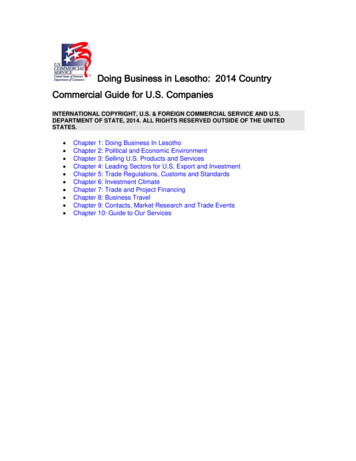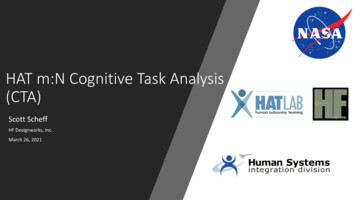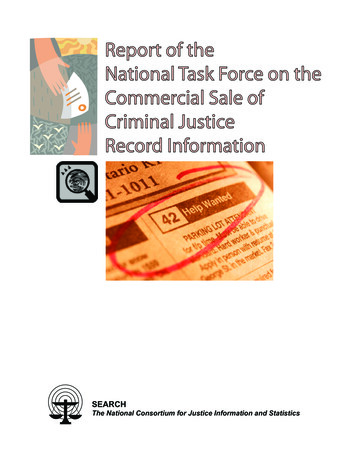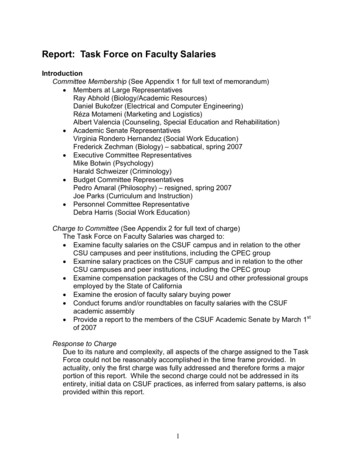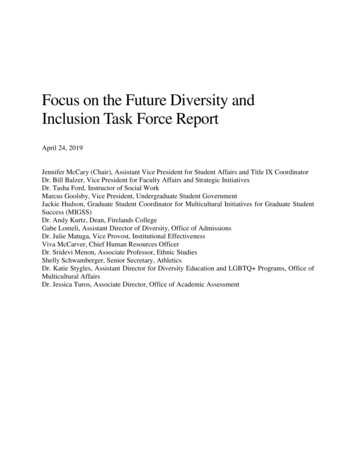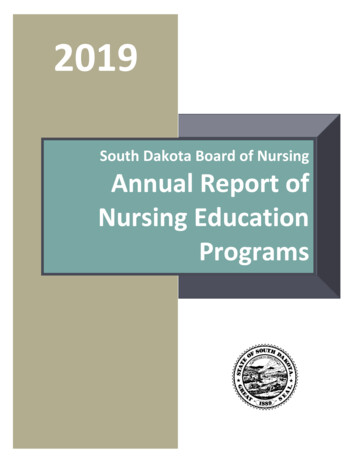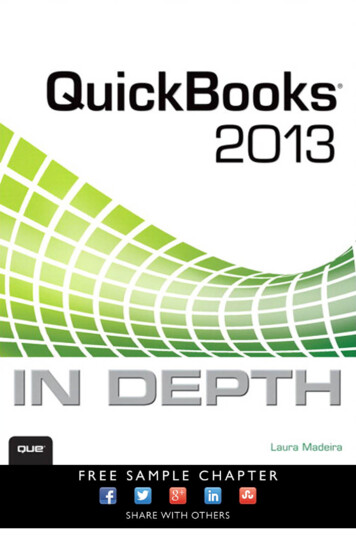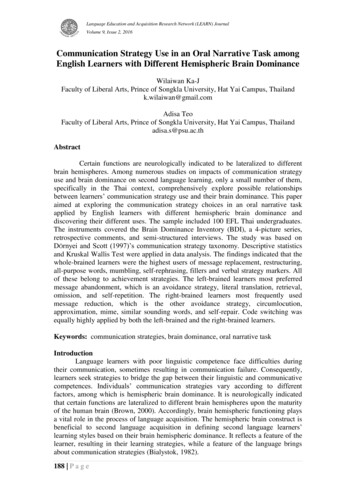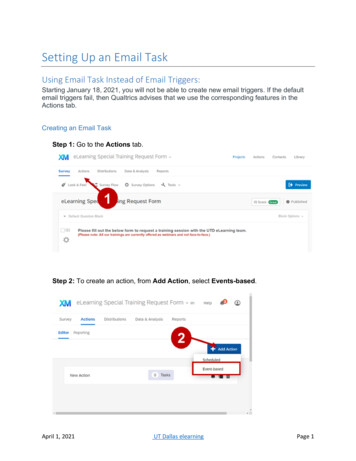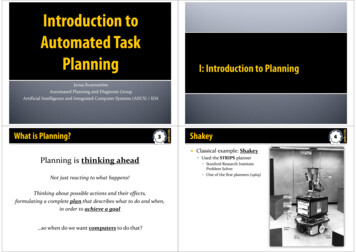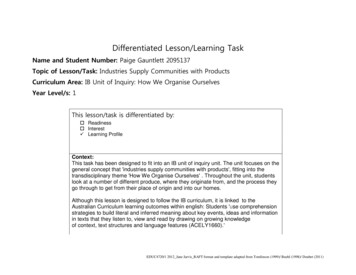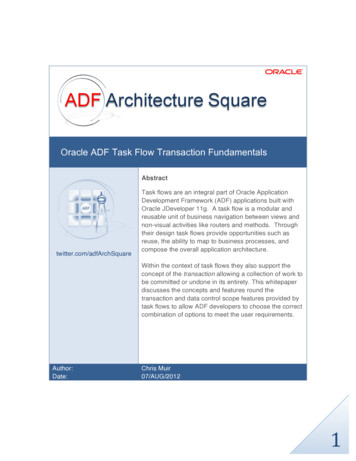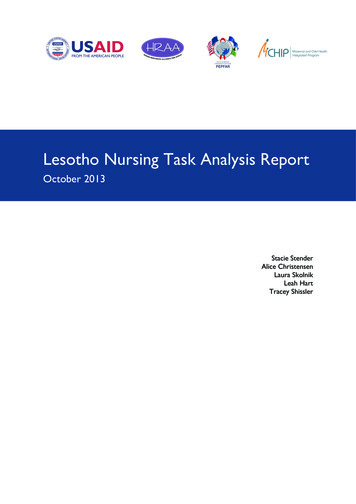
Transcription
Lesotho Nursing Task Analysis ReportOctober 2013Stacie StenderAlice ChristensenLaura SkolnikLeah HartTracey Shissler
Lesotho Nursing Task Analysis ReportOctober 2013Stacie StenderAlice ChristensenLaura SkolnikLeah HartTracey Shissler
2013 by Jhpiego Corporation. All rights reserved.The Human Resources Alliance for Africa (HRAA) project is a regional five-year (2011-2016) human capacitydevelopment effort funded by USAID through a Strategic Objective Agreement (SOAG) award. HRAA is ledby the East, Central and Southern Africa Health Community (ECSA-HC). Please visithttp://www.ecsahc.org/projects.php?id 1 to learn more.The Maternal and Child Health Integrated Program (MCHIP) is the USAID Bureau for Global Health’s flagshipmaternal, neonatal and child health (MNCH) program. MCHIP supports programming in maternal, newbornand child health, immunization, family planning, malaria and HIV/AIDS, and strongly encourages opportunitiesfor integration. Cross-cutting technical areas include water, sanitation, hygiene, urban health and healthsystems strengthening.www.mchip.net
Table of ContentsAbbreviations and Acronyms . viAcknowledgments . viiExecutive Summary . ixBackground . ixData and Methods . ixKey Findings . ixRecommendations . xBackground and Introduction . 1Lesotho . 1Task Analysis. 4Objectives . 5Methods . 6Application to Conduct Research . 7Development and Validation of the Task List. 7Sampling . 8Participant Recruitment . 9Data Collection . 9Analysis of Results . 11Limitations of Methodology of Task Analysis . 12Results . 13Demographic Analysis . 13Frequency Analysis by Four Task Measurement Areas . 17Frequency (Table A-3 in the Annex) . 19Criticality (Table A-4 in the Annex) . 24Setting of Education/Training (Table A-5 in the Annex) . 26Perceived Competence in Performance (Table A-6 in the Annex) . 28Cross-Tabulations of Four Task Measurement Areas and Implications. 31Discussion and Conclusions . 35Nursing Practice and Education . 36HIV/AIDS . 38Maternal and Child Health . 39Tuberculosis. 40Cervical Cancer . 41Other Health Priorities . 41Nursing Regulation . 42Study Strengths and Limitations . 43Recommendations . 44Annex . 50References . 78Lesotho Nursing Task Analysis Reportiii
LIST OF TABLES AND FIGURESTable 1: Leading Causes of Years of Life Lost in Lesotho in 2010 and Comparison to 1990 . 2Table 2: Cross-Tabulation Options for the Four Task Measurement Areas Analyzed . 12Table 3: Participant Distribution across Districts . 13Table 4: Demographic Information of Participants by Response Group . 14Table 5: Number of Participants According to Designation and Type of Workplace . 17Table 6: Tasks Never Done: Those that More than Half of ParticipantsReported They Never Do . 20Table 7: Measurement of Frequency for Task 21 “Perform rapid test for HIV’by Type of Facility . 21Table 8: Ranking by Percentage of Participants Reporting Doing the Task Daily orWeekly, by Type of Facility* . 22Table 9: Ranking by Percentage of Participants Reporting Doing the Task Never orRarely, by Type of Facility . 23Table 10: Measurement of Frequency for Task 9 “Participate in clinical teaching ofnursing students” by Type of Facility . 23Table 11: Tasks with Statistically Significant Difference in Criticality as Ratedby Participants from Different Facility Types . 25Table 12: Tasks with Statistically Significant Difference in Setting ofEducation/Training, as Rated by Participants from Different Facility Types . 27Table 13: Tasks Learned “On the Job” by at Least Half of Participants,Disaggregated by Facility Type . 28Table 14: Tasks for which the Largest Percentage of Participants PerceivedThemselves as “Not Competent” . 29Table 15: Tasks with Statistically Significant Difference in Self-Perceived Competence inPerformance, as Rated by Participants from Different Facility Types . 30Table 16: Ranking of Tasks for Each of the Four Task Measurement Areas. 31Table 17: Cross-Tabulation for the Top 20 Tasks Reported as Low Frequency,High Criticality. 32Table 18: Cross-Tabulation for the Top 20 Tasks Reported as High Frequency,Low Criticality . 33Table 19: Cross-Tabulation for Top 20 Tasks Reported as High-Criticality,Never Trained or Not Trained in Pre-service . 34Table 20: Cross-Tabulation for Top 20 Tasks Reported as High Criticality,Low Self-Perceived Competence in Performance . 35Table A-1: Expert Panel for Validation of Task List . 50Table A-2: Lesotho Nursing Task List . 51Table A-3: Reported Frequency at Which Tasks Are Performed . 55Table A-4: Reported Criticality of Tasks Performed . 60Table A-5: Reported Education/Training for Tasks Performed . 65Table A-6: Reported (Self-Perceived) Level of Competence in Tasks Performed . 70Table A-7: Tasks, Disaggregated by Level of Facility, that 90% ofParticipants Reported Doing at Least Weekly . 76ivLesotho Nursing Task Analysis Report
Table A-8: Tasks That More than Half of Participants Reported Not Learning orLearning Outside of Pre-service Education . 77Figure 1: Ten Districts of Lesotho. 1Figure 2: Number of Participants for Each Level of Facility per District. 16Figure 3: Average Number for Each Response to Task Measurement Area: Frequency . 18Figure 4: Average Number for Each Response to Task Measurement Area: Criticality . 18Figure 5: Average Number for Each Response to Task Measurement Area: Setting ofEducation/Training . 19Figure 6: Average Number for Each Response to Task Measurement Area: Perceived Competence inPerformance . 19Figure 7: Criticality of Tasks 52 and 67 Disaggregated by Type of Facility. 25Figure A-1: Comparison of Tasks That the Largest and Smallest Percentages of Participants ReportedConducting Weekly or Daily . 75Lesotho Nursing Task Analysis Reportv
Abbreviations and USAIDUSDVIAWHOYLLviAntenatal careAntiretroviral therapyChristian Health Association of LesothoCommunity health workerContinuing professional developmentCardiopulmonary resuscitationDirectly Observed Therapy Short-CourseEast, Central and Southern Africa–Health CommunityExpanded Program on ImmunizationEssential Service PackageGender-based violenceGross domestic productGovernment of LesothoHuman papillomavirusHuman resourcesHuman resources for healthHuman Resources Alliance for AfricaHealth Service AreasLesotho Nurses AssociationLesotho Nursing CouncilMaluti Adventist School of NursingMaternal and child healthMaternal and Child Health Integrated ProgramMulti-drug resistant tuberculosisMinistry of HealthNational Council of State Boards of NursingNational Health Training CollegeNational University of LesothoOral rehydration solutionPresident’s Emergency Plan for AIDS ReliefPrimary health centerProvider-initiated [HIV] testing and counselingPrevention of mother to child transmission [of HIV]Public-private partnershipPoverty Reduction Strategy PaperPre-service educationReaching Every District ApproachRegistered midwifeRegistered nurseScott School of NursingTuberculosisUnited States Agency for International DevelopmentUnited States dollarVisual inspection with acetic acidWorld Health OrganizationYears of life lostLesotho Nursing Task Analysis Report
AcknowledgmentsThe Human Resources Alliance for Africa (HRAA) project and the Maternal and Child HealthIntegrated Program (MCHIP) thank the Ministry of Health, the Christian Health Association ofLesotho (CHAL), the Lesotho Nursing Council (LNC), and the many nurses and nursemidwives in Lesotho for their contributions to the nursing task analysis.This study and accompanying report were made possible through the generous support of theAmerican people through the U.S. Agency for International Development (USAID) and thePresident’s Emergency Plan for AIDS Relief (PEPFAR), under the terms of the HRAA StrategicObjective Agreement (SOAG) 690-0020. The prime recipient is the East, Central, and SouthernAfrica Health Community (ECSA-HC); Jhpiego Corporation is a sub-recipient organization.This report was made possible, in part, by the generous support of the American people throughUSAID, under the terms of the Leader with Associates Cooperative Agreement GHS-A-00-0800002-00. The contents are the responsibility of the Maternal and Child Health IntegratedProgram MCHIP and do not necessarily reflect the views of USAID or the United StatesGovernment.We also acknowledge publications support from Jhpiego: Rebecca Fowler, editing; RenataKepner, desktop publishing.Lesotho Nursing Task Analysis Reportvii
viiiLesotho Nursing Task Analysis Report
Executive SummaryBACKGROUNDThe Human Resources Alliance for Africa (HRAA) project seeks to build human resourcemanagement capacity in countries with serious health workforce shortages, such as Lesotho.Lesotho’s predominantly rural population faces significant health challenges within a setting ofinadequate human resources for health. It is essential that nurses and nurse-midwives, whotogether make up the largest health workforce in the country, be adequately prepared to addressLesotho’s Health Priorities according to the Poverty Reduction Strategy Paper (PRSP) in thesettings where they work. Under the HRAA project, Jhpiego conducted a task analysis study toobtain data on job duties or tasks performed by these cadres, as well as information about howoften the tasks are performed, if and where tasks were learned, and the self-perceived level ofcompetence in performing the tasks.This report and the study results it contains are intended for Lesotho nursing and midwiferyeducation and regulation leaders to use for a variety of purposes. Some activities that wereprioritized by these stakeholders as outputs from the task analysis study include: creating a set ofcore nursing competencies, revising scopes of practice, developing national nursing andmidwifery standards, reviewing and updating curriculum, and laying the groundwork for theareas of focus of a new graduate mentorship program that will support new graduates as theytransition to practice.DATA AND METHODSTask analysis is a descriptive study method that utilizes self-reporting by a health care cadre todetermine what tasks are performed by workers in that cadre. Task analysis is used to identify thecurrent reality of practice, providing a data set that can then be used to inform various activitiesrelevant to human resource strengthening, such as revision of curriculum content, adjustment orverification of the scope and standards of practice, revision of job descriptions and deploymentpractices, and the updating of licensure examinations.In this study, the methodology entailed seeking responses primarily from practicing nurses andnurse-midwives in four key measurement areas by task: FREQUENCY at which the task isperformed; CRITICALITY of the task to patient/public health outcome; setting where theprovider received EDUCATION/training on the task; and the provider’s self-perceived level ofcompetence in PERFORMANCE of the task.Nurses and nurse-midwives who had graduated from a nursing or midwifery education programwithin the last six months to four years were included in the study. Data were collected through acard game that Jphiego developed for the purpose of task analysis—Task Master: Mining forData . One hundred and seventy individuals participated in the study.KEY FINDINGSThe results of the task analysis provided an overview of tasks that are frequently done by nursesand nurse-midwives currently in practice, which tasks are perceived to be critical for improvedhealth,
PITC Provider-initiated [HIV] testing and counseling PMTCT Prevention of mother to child transmission [of HIV] PPP Public-private partnership PRSP Poverty Reduction Strategy Paper PSE Pre-service education RED Reaching Every District Approach RM Registered midwife RN Registered nurse SSN
